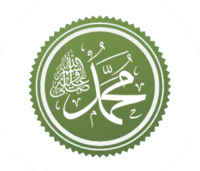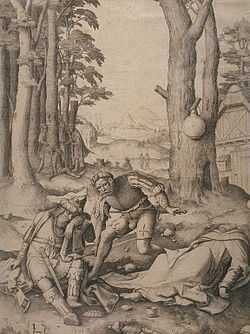Bahira
| Part of a series on |
| Muhammad |
|---|
 |
|
Views |
|
Related
|
|
Bahira (Arabic: بحيرى, Classical Syriac: ܒܚܝܪܐ), or "Sergius the Monk" to the Latin West, was a Syriac or Bahrani[1] Gnostic Manichean Nasorean or Nestorian (or Arian[2]) monk who, according to tradition, foretold to the adolescent Muhammad his future prophetic career.[3][4]
Islamic tradition

The story of Muhammad's encounter with Bahira is found in the works of the early Muslim historians Ibn Hisham, Ibn Sa'd al-Baghdadi, and Muhammad ibn Jarir al-Tabari, whose versions differ in some details. When Muhammad was either nine or twelve years old, he met Bahira in the town of Bosra in Syria during his travel with a Meccan caravan, accompanying his uncle Abu Talib ibn ‘Abd al-Muttalib.[3] When the caravan was passing by his cell, the monk invited the merchants to a feast. They accepted the invitation, leaving the boy to guard the camel. Bahira, however, insisted that everyone in the caravan should come to him.[4] Then a miraculous occurrence indicated to the monk that Muhammad was to become a prophet.
It was a miraculous movement of a cloud that kept shadowing Muhammad regardless of the time of the day. The monk revealed his visions of Muhammad's future to the boy's uncle (Abu Talib), warning him to preserve the child from the Jews (in Ibn Sa'd's version) or from the Byzantines (in al-Tabari's version). Both Ibn Sa'd and al-Tabari write that Bahira found the announcement of the coming of Muhammad in the original, unadulterated gospels, which he possessed; the standard Islamic view is that Christians corrupted the gospels, in part by erasing any references to Muhammad.[3]
Christian tradition

In the Christian tradition Bahira became a heretical monk, whose errant views inspired the Qur'an. Bahira is at the center of the Apocalypse of Bahira, which exists in Syriac and Arabic which makes the case for an origin of the Qur'an from Christian apocrypha. Certain Arabist authors maintain that Bahira's works formed the basis of those parts of the Qur'an that conform to the principles of Christianity, while the rest was introduced either by subsequent compilers such as Uthman Ibn Affan or contemporary Jews and Arabs." The names and religious affiliations of the monk vary in different Christian sources. For example, John of Damascus (d.749), a Christian writer, states that Muhammad "having chanced upon the Old and New Testaments and likewise, it seems, having conversed with an Arian monk, devised his own heresy."[5]
For Abd-al-Masih al-Kindi, who calls him Sergius and writes that he later called himself Nestorius, Bahira was a Nasorean, a group usually conflated with the Nestorians. After the 9th century, Byzantine polemicists refer to him as Baeira or Pakhyras, both being derivatives of the name Bahira, and describe him as an iconoclast. Sometimes Bahira is called a Jacobite or an Arian.
Bibliography
- Maulana Muhammad Al (2002), The Holy Qur'an: Arabic Text with English Translation and Commentary, New Addition, Ahmadiyya Anjuman Isha’ at Islam Lahore Inc., Ohio, USA.
- Osman Kartal (2009), The Prophet’s Scribe Athena Press, London (a novel)
- B. Roggema, The Legend of Sergius Baḥīrā. Eastern Christian Apologetics and Apocalyptic in Response to Islam (The History of Christian-Muslim Relations. Texts and Studies 9; 2008) (includes editions, translations and further references).
- K. Szilágyi, Muhammad and the Monk: The Making of the Christian Baḥīrā Legend, Jerusalem Studies in Arabic and Islam 34 (2008), in press.
- Abel, A. (1935) “L'Apocalypse de Bahira et la notion islamique du Mahdi” Annuaire de l'Institut de Philologie et d'Histoire Orientale III, 1-12. Alija Ramos, M.
- Griffith, S. H. (1995). "Muhammad and the Monk Bahîrâ: Reflections on a Syriac and Arabic text from early Abbasid times". Oriens Christianus (in English). Vol. 79: pp. 146–174. ISSN 0340-6407. OCLC 1642167.
- Griffith, S. H. (January 2000). "Disputing with Islam in Syriac: The Case of the Monk of Bêt Hãlê and a Muslim Emir". Hugoye: Journal of Syriac Studies. Vol. 3 (No. 1).
References
- ↑ Al-Masudi, "Muruj adh-dhahab wa ma'adin al-jawhar" ,وقال المسعودي، ت : 345 هـ إن بحيرا الراهب على دين المسيح عيسى بن مريم، واسم بحيرا في النصارى سرجس، وكان من عبد القيس.
- ↑ Jean Damascène, Des hérésies, chap. CI.
- ↑ 3.0 3.1 3.2 Abel, A. "Baḥīrā". Encyclopaedia of Islam. Brill. Brill Online, 2007
- ↑ 4.0 4.1 Watt, W. Montgomery. Muhammad: Prophet and Statesman, p. 1. Oxford University Press, 1964
- ↑ St. John of Damascus's Critique of Islam; from Writings, by St John of Damascus (De Haeresibus, chap. 101), The Fathers of the Church vol. 37 (Washington, DC: Catholic University of America Press, 1958), pp. 153-160.